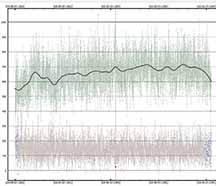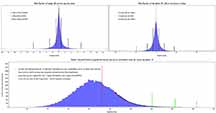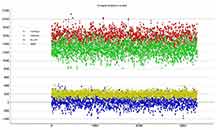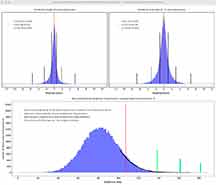


This is a short event only 0.3s, alt=35 in Sagittarius. Will require short integration to get it. Near Bradley. It's relatively bright, so offers a bit of confidence we can get a detectable event, and if Kirk and I are not too far from each other, can re-inforce the confidence if we get the same results.
 |
 |
 |
We managed to make it all the way to Bradley in time to use this as our occultation observation site, saving time in the return to Santa Cruz. We had clear skies, no smoke, but a fairly obvious breeze coming down the Salina Valley, as is typical. The breeze was out of the north, and the target was due south, so we were able to isolate ourselves from the wind well enough that it didn't ruin our observations. I set up just south of the centerline, and Kirk on the north side, but both of us were well inside the predicted path.
I used the Cabrillo van as a wind break, and got better wind break by half-closing the doors. I got on target without problem. The trouble with this difficult event is how faint the star was against a moonlit sky, and the duration of only 0.3s. It required using 2x integration, but which then made the S/N pretty poor. Nevertheless, I did get 5 consecutive points at "zero" (= the level of the sky) right at the predicted time. The bad news was that I had many other moments when 1 or even once in a while, 2, points were also at zero level, and so while PyOTE could ID the event, it did not let it pass with any real significance. However, Kirk also had an event at the predicted time, and it passed with much higher significance, but still only about 3-sigma. My event was only 0.188 sec long.
I might be able to improve that with TME apertures or by trying w/o the vertical median noise filtering which is what I've first done and shown below.
magDrop report: percentDrop: 77.8 magDrop: 1.635 +/- 0.628 (0.95 ci) (see below for comment)
DNR: 1.79
D time: [03:30:21.0274]
D: 0.6800 containment intervals: {+/- 0.0157} seconds
D: 0.9500 containment intervals: {+/- 0.0527} seconds
D: 0.9973 containment intervals: {+/- 0.1278} seconds
R time: [03:30:21.2158]
R: 0.6800 containment intervals: {+/- 0.0157} seconds
R: 0.9500 containment intervals: {+/- 0.0527} seconds
R: 0.9973 containment intervals: {+/- 0.1278} seconds
Duration (R - D): 0.1884 seconds
Duration: 0.6800 containment intervals: {+/- 0.0245} seconds
Duration: 0.9500 containment intervals: {+/- 0.0640} seconds
Duration: 0.9973 containment intervals: {+/- 0.1374} seconds
Note - because of my severely clipped sky counts, the actual mag drop was ~100%, as you can see below on the solution plot that includes the sky counts. How this affected the calculation of the false positive test is not known (by me). I judge this first analysis as giving slightly better more believable results compared to Kirk's better positive 1.5 mi further north, and will be the one I turn in to IOTA. But, it will be judged 'unsure'.
|
Confidence is low. But Kirk had a similar event at the proper time, also low confidence but significantly better than my FP test. The poor seeing and wind, makes me think being detectable is about all we could hope for, and not, alas, strong FP results. |
RN: I will report my own results as a "positive" and let the auditors do with this event as they will.
==========================================================================================
For my second attempt, I cut the radius of the circular fixed aperture to 3px instead of 4x, and also did not apply a median vertical noise reduction. I also trimmed the first and last 30s which showed stronger variance in the ref1 star due to ? aerosols? not sure what. Anyway, It did not improve the false positive test. The duration was now 0.16s
magDrop report: percentDrop: 73.3 magDrop: 1.432 too much noise; cannot calculate error bars
DNR: 1.91
D time: [03:30:21.0558]
D: 0.6800 containment intervals: {+/- 0.0315} seconds
D: 0.9500 containment intervals: {+/- 0.1186} seconds
D: 0.9973 containment intervals: {+/- 0.3021} seconds
R time: [03:30:21.2158]
R: 0.6800 containment intervals: {+/- 0.0315} seconds
R: 0.9500 containment intervals: {+/- 0.1186} seconds
R: 0.9973 containment intervals: {+/- 0.3021} seconds
Duration (R - D): 0.1600 seconds
Duration: 0.6800 containment intervals: {+/- 0.0570} seconds
Duration: 0.9500 containment intervals: {+/- 0.1682} seconds
Duration: 0.9973 containment intervals: {+/- 0.3738} seconds
 |
 |
 |
 |
 |
|
Noisy, but detectable by PyOTE |
Kirk and I were about 1 asteroid radius apart. But the event had high rank, so it's likely we would both have positive events, if noisy. |
For Adamfields near Bradley, Sep 14, at 4x: Light curve is very noisy, and not much above background. I tried both a 12 stack of static apertures and TME, the best results were with a static aperture of size 2.0. After normalizing on a tracking star, I used min/max, and it automatically found a very rough event at about event time. The OWC event page warns of nearby stars, a 6.1 m drop for the target, for 4" a 4.8 m drop, for 8" a 1.6m drop. The PyOTE detectability test says "An event of duration 0.300 seconds with magDrop: 1.6 is likely detectable." My PyOTE results, are for a R-D of .3337 sec. so it would seem theoretically detectable. However, it fails 3 sigma in the false positive test. So probably only of use maybe to support a positive observation from another station.
magDrop report: percentDrop: 54.4 magDrop: 0.853 +/- 0.493 (0.95 ci)
DNR: 1.92
D time: [03:30:20.7173]
D: 0.6800 containment intervals: {+/- 0.0436} seconds
D: 0.9500 containment intervals: {+/- 0.1651} seconds
D: 0.9973 containment intervals: {+/- 0.3651} seconds
R time: [03:30:21.0510]
R: 0.6800 containment intervals: {+/- 0.0436} seconds
R: 0.9500 containment intervals: {+/- 0.1651} seconds
R: 0.9973 containment intervals: {+/- 0.3651} seconds
Duration (R - D): 0.3337 seconds
Duration: 0.6800 containment intervals: {+/- 0.0705} seconds
Duration: 0.9500 containment intervals: {+/- 0.2035} seconds
Duration: 0.9973 containment intervals: {+/- 0.4495} seconds
 |
 |
 |
A detectable event at the right time. But noise limited for sure, like mine. |
 |